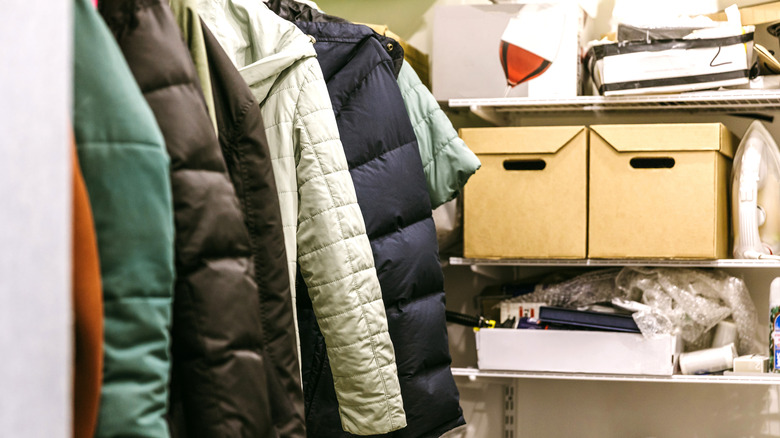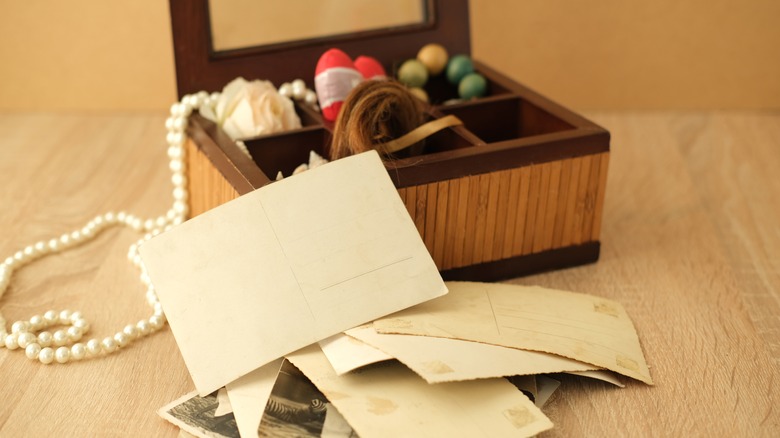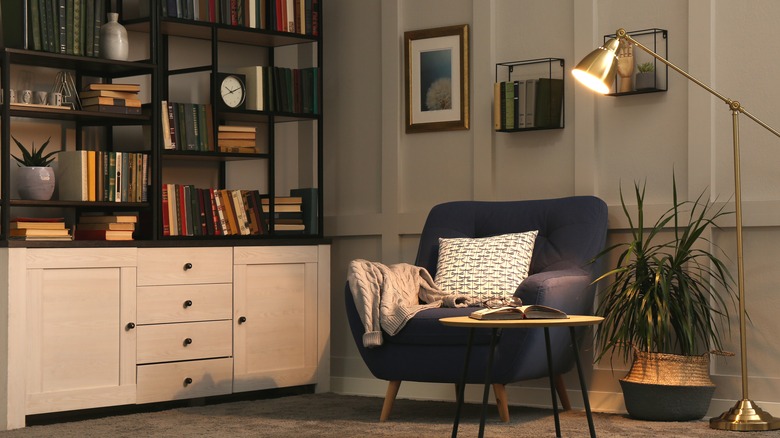What Is Swedish Death Cleaning And Why Should You Do It?
Don't let the name scare you. Regardless of how it sounds, Swedish Death Cleaning is in great part about celebration. And according to Margareta Magnusson, the person responsible for the practice's recent notoriety, per Realtor, it offers some relief from fear –- the fear of death. Perhaps the concept feels easier if referred to as döstädning. Dö is "death" and städning is "cleaning." In her book, Magnusson explains, "In Swedish it is a term that means that you remove unnecessary things and make your home nice and orderly when you think the time is coming closer for you to leave the planet" (via Food 52). Touted as something for the over-50 crowd to be concerned with, Magnusson says we can start bringing awareness to the stuff we hang onto at any age as a way of living with freedom from our things and developing an identity that doesn't rely on possessions.
Death cleaning hinges simply on one straightforward but crucial question while combing through items meant for saving, gifting, donating, or tossing. "Will anyone I know be happier if I keep this?" It's at once extremely pragmatic and emotionally sensitive, as is the country's funeral tax, which an individual pays throughout their life to cover the basic expenses associated with their passing, taking the onus off of family members (via ITV News). While Magnusson believes downsizing and organizing render the gift of reduced stress and a lighter existence for ourselves, she sees it equally as an act of love toward others.
What does it all mean?
Margareta Magnusson, the author of "The Gentle Art of Swedish Death Cleaning: How to Free Yourself and Your Family from a Lifetime of Clutter," is not someone we would consider a minimalist. Speaking from her Stockholm apartment, she is surrounded by book-laden shelves, artwork, and thriving houseplants (via Versilio Studio). It isn't messy, but it's not ascetic either. It looks like the home of a person who appreciates and has a joyful attachment to their belongings. It's a bit unexpected given the title of her publication, although we're comforted to see it. Even more jarring is her bare storage unit (except for a lone bicycle) and the knowledge that all of her worldly possessions fit into a two-room residence. "Death cleaning is not about dusting or mopping up," Magnusson said in Country Living. "It is about a permanent form of organization that makes your everyday life run more smoothly."
Per Real Simple, the objective of Swedish Death Cleaning is to save families the weight of having to organize, declutter, and throw away their beloved's items after death, a task made potentially more difficult while grieving. "One day when you're not around anymore, your family would have to take care of all that stuff. I don't think that's fair really," said Magnusson (via Versilio Studio). The book serves as a guide for the process of downsizing, which she feels should start at no later than 65 years young and continue almost indefinitely.
Where do we begin?
We amass an inordinate amount of things during our lifetimes. Home organizer and blogger Do It On A Dime notes that according to Margareta Magnusson, those habits are motivated primarily by three factors: a hoarding instinct, a clutter instinct, and a fear of death. We gather items to create a sense of comfort and plenty and more primally as a vestige of a survival impulse; ironically, that stuff can take over our spaces. "Life will become more pleasant and comfortable if we get rid of some of the abundance," Magnussen asserts in her book (via Stored).
How and where do we begin? According to Stored, Magnusson suggests we start in storage areas like attics, basements, and utility closets; these are places for warehousing practical items, those not fundamental to everyday function, or less noteworthy objects — generally speaking, items with little sentimental attachment. Assign a category for every piece, including save, gift, sell, donate, or dispose. Next, she recommends taking stock of larger possessions, such as furniture, books, and decorative objects with fresh eyes. "Just look around you. Several of your things have probably been there for so long that you do not even see or value them anymore," Magnussen contends in an excerpt (via Food 52). Per Realtor, she directs us to proceed room by room, compiling a comprehensive list of all items and grouping them as outlined above; allow about a week to tackle each space.
The last step
Per Stored, you should follow up living spaces with the organizing of clothes closets, wardrobes, and drawers. Be ruthless and stop holding onto things for special occasions only; instead, enjoy them now or make a present of them to someone else. Further, Margareta Magnusson suggests leaving written details concerning anything of provenance or consequential monetary value.
The remaining step is left to the last for a reason. According to Realtor, Magnusson recommends that the straightening of sentimental objects should come at the end of the process because they can be a distraction. They're often the most grueling to go through and hardest to part with. Once again, ask family members if there is anything they would care to have. However, only we may find meaning in an assortment of photos, letters, and tchotchkes; Magnusson has collected those very personal things into a bin expressly labeled for disposal. "I have a throwaway box — my children or friends can just throw it away without looking at it because those things are just for me."
Passing on a clutter-free life
It's important to communicate with friends and family during the process, and per Margareta Magnussen, it might provide an opportunity to discuss difficult topics. "Many adult children do not want to talk about death with their parents. They should not be afraid. We must all talk about death," Magnusson explained in Food 52. "If it's too hard to address, then death cleaning can be a way to start the conversation."
Involving close friends and family in decluttering makes them aware of the practical and considerate intention behind what could otherwise seem like rash or severe behavior. Additionally, it affords the chance to bequeath items of value to those who specifically admire them. Yet, according to Stored, people should be encouraged to be honest with their preferences. "Don't save things for your children if they don't tell you this is something that I would like to have," Magnusson told ITV News. The purpose of Swedish Death Cleaning is not to continue a cycle of clutter but to leave room for memories, old and new.




